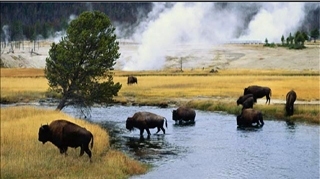|
Squirrel Bounties
Archives – County records – receipt books for June-July 1894 for squirrel
scalps turned in. Archives ladies have abstracted them into our Squirrel
Bounty Book which lists in alphabetical order the name of each person with
the total number of scalps. Numbers range from several bringing in 1 to 288
brought in by Mrs. D. I. Brown
Not tree squirrels but ground squirrels, also called gophers – pests in
gardens, fields
Thanks of Kearney Public Library which has all the Hubs up to Oct.1905 which
was the source of this information.
1891 – Gophers were unusually bad that year. (and this was only June)
They eat corn and other crop seeds.
The recommendation was being made to
farmers to carry a vial of bi sulphuret of carbon (a now unused term,
probably for a strong poison) in his pocket along with a wad of cotton. When
he saw a gopher hole he could soak a small piece of the cotton with this
chemical, put in the burrow and then close up the opening. The fumes would
kill the ground squirrels.
They were warned not to handle this
chemical around fires as it was highly flammable and not to keep it in the
house. It could also be used to kill other burrowing animals such as prairie
dogs and rabbits.
Fall elections 1891 – Voters authorized the County Board of Supervisors to
pay a bounty of 3˘ each for gopher scalps and $1 for each wolf (coyote?)
scalp.
Between Jan 7 & Oct. 25, 1892 – 12,000 gopher scalps were brought in.
Boys would bring one or two at a time
which got to be such a nuisance the rule was established of a minimum of
seven scalps turned in at a time.
300 wolf scalps were turned in.
The scalps were then buried.
September 17, 1894 – (little item in the paper) - Up to two o’clock
on that day warrants had been issued for 684 gopher scalps. ($20.52) A total
of $3000 had been paid out that year up through September 1. (100,000
scalps)
October 26, 1894 – The September news item raised some questions.
A total of $3,283.75 had been paid
out from Jan – August.
Jan – $40.02 May – $363.07
Feb – $79.47 June – $809.56 ) the
time of our receipt books
Mar – 42.42 July – $1,101.64
)
Apr – $105.80 Aug – $713.89
County clerk and his deputy never
questioned the number of scalps coming in.
Chute outside the window where they
dumped the scalps
Janitor burns them each evening.
Even allowing for $400 per month
which is more than any other month, the county lost over $1,400.
Rumors –
Someone had a duplicate key to the box at the bottom of the chute and was
stealing the scalps to be turned in again.
The janitor was supposed to have the
only key but he was not suspected.
Several boys in town were questioned by the police
They said they bought scalps from
country boys.
There was no proof they were lying so
they were released.
There was also no proof against the
person or persons suspected of taking the scalps from the box.
At the next meeting of the County
Board an investigation was to be demanded.
Both the county clerk and the janitor wanted this to clear their names.
Judge Holcomb was also asked to call
a grand jury to investigate.
The suspected individuals would be called to testify and it was believed
some would weaken.
October 27, 1894 (next day) – Factious proposal that the county’s
financial woes could be solved by coinage if the gopher scalps at the rate
of 16 coins from each skin like some ancient peoples had done.
December 27, 1894 – In 11 months of the year a total of $3,826.26 was
paid out which meant that 127,542 scalps had been turned in.
Nothing more about an investigation
or a grand jury
June 1895 – The county treasurer refused to register gopher scalp
warrants.
Said there was no law for the payment
of the warrants so they were illegal.
Hub called this one of the
leading industries of the county since the bounty had been voted in in 1891.
As a test case Sheriff Nutter had
turned in two scalps and presented the warrants to the treasurer to be paid.
When he was refused he went to Judge Sinclair asking for a writ of mandamus
compelling the treasurer to pay the warrant.
Two weeks later – Judge Sinclair upheld the treasurer’s position on
the grounds that there was no statute authorizing such an expenditure or the
payment of the warrants.
“There was general rejoicing
in gopherdom.”
Farm boys were not happy to have
this source of income cut off.
For example,
on July 1 the clerk had issued warrants for $177 for gopher bounties. If
these had been paid, the money would have gone into circulation for
firecrackers and lemonade for the Fourth of July.
A new motion for hearing was to be
made to Judge Easterling.
Nothing more reported – No more
bounties
Concept of bounty on gopher scalps not new.
In 1872-3 the State of Nebraska was
paying 15˘ per scalp.
June 17, 1903 – Found in State
Auditor’s office - a claim made in 1901
Man from
Richardson County submitted a claim for $125.75 for 839 gophers killed in
1872 & 1873 by 18 different people.
Affidavits
from county clerk & deputy clerk verifying the claim
The man
presenting the claim was not one of the 18 people who killed the ground
squirrels.
|

